
Vianden in the Our valley. (1284k)
From the Luxembourg City entry in Wikipedia:
Vianden is a commune with town status in the Oesling, north-eastern Luxembourg, with over 1,800 inhabitants. It is the capital of the canton of Vianden, which is part of the district of Diekirch. Vianden lies on the Our river, near the border between Luxembourg and Germany. It is known for its castle.
The origins of Vianden date back to the Gallo-Roman age when there was a castellum on the site of the present castle. The original name of Vianden was Viennensis. The valley was covered in vineyards in Roman times, the first historical reference to Vianden was in 698 when there is a record of a gift in the form of a vineyard in Monte Viennense made by Saint Irmina to the Abbey of Echternach. Vianden possesses one of the oldest charters in Europe, granted in 1308 by Philip II, count of Vianden, from whom the family of Nassau-Vianden sprang, and who was consequently the ancestor of William of Orange.
In the Middle Ages, Vianden's craftsmen were recognised for their skills as tanners, drapers, weavers, barrelmakers, masons, locksmiths and goldsmiths. In 1490, they created guilds for their various trades. Over the years pig-farming and leathermaking became the major industry with the establishment of two tanneries at the end of the 19th century which finally closed in the mid-1950s.
The castle was built between the 11th and 14th centuries and became the seat of the counts of Vianden. It was further developed until the 18th century but with the departure of the Counts of Luxembourg to the Netherlands combined with the effects of fire and an earthquake, it slowly deteriorated. The final blow came in 1820 when William I of the Netherlands sold it to a local merchant who in turn sold off its contents and masonry piecemeal, reducing it to a ruin. There were several attempts at restoration but these were hampered by problems of ownership. Still, the chapel which forms part of it was restored in 1849 by Prince Henry of the Netherlands, and during one of his visits to the town Victor Hugo lived in the castle for three months in 1871. Not until 1977, when Grand Duke Jean ceded the castle to the State, was it possible to undertake large-scale work, most of which has now been completed.
Vianden is also remembered as the site of multiple battles in World War II. In November 1944 it saw fierce combat between the Luxembourg Resistance and German forces. It was the last place in Luxembourg to be freed from the Germans in February 1945 when the Americans completed Luxembourg's liberation. A memorial to the west of the town, overlooking the castle, commemorates this final battle.
All pictures are © Dr. Günther Eichhorn, unless otherwise noted.




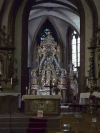
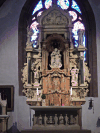
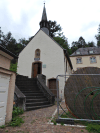


Vianden Castle, located in Vianden in the north of Luxembourg, is one of the largest fortified castles west of the Rhine. With origins dating from the 10th century, the castle was built in the Romanesque style from the 11th to 14th centuries. Gothic transformations and trimmings were added at the end of this period. A Renaissance mansion was added in the 17th century but thereafter the castle was allowed to fall into ruins. It has, however, recently been fully restored and is open to visitors.
The castle was built on the site of an ancient Roman castellum. The basement appears to have been a Carolingian refuge. Historically, the first Count of Vianden was mentioned in 1090. The castle continued to be the seat of the Vianden's influential counts until the beginning of the 15th century.
Around 1100, a square keep was built as well as a kitchen, a chapel and residential rooms indicating that an aristocratic family lived there at the time. During the first half of the 12th century, a new residential tower and a prestigious decagonal chapel were added while the palace itself was extended. At the beginning of the 13th century, a new two-storey palace measuring 10 x 13 m (30 x 43 ft) was built with a sumptuous gallery connecting it to the chapel. These additions show how the Counts of Vianden sought to rival the House of Luxembourg. The last great change took place in the middle of the 13th century when the entire castle was adapted to reflect the Gothic style. Finally, in 1621 the Nassau Mansion with its banqueting hall and bedroom was built by Prince Maurice of Orange-Nassau-Vianden in the Renaissance style replacing a damaged side wing of the 11th century keep.
During the 16th century, the castle was more or less abandoned by the Counts of Vianden who had gained the additional title of the House of Nassau-Orange after Elisabeth, the granddaughter of Henry II of Vianden had willed the County of Vianden together with its castle to her cousin, Count Engelbert of Nassau. This initiated the long association between Vianden and the House of Nassau. In 1564, William the Silent, Prince of Orange, Count of Nassau and of Vianden, took an initial interest in Vianden where he built the first blast furnace in Luxembourg but left in 1566 to lead the Dutch revolt against King Philip II of Spain. As a result, Philip confiscated the castle and conferred it on Peter Ernst von Mansfeld, the governor of Luxembourg.
In 1820, King William I sold the castle to Wenzel Coster, an alderman, for 3,200 florins. Coster started to demolish the building, selling off the tiles from the roof, the wooden panelling, the doors and the windows piece by piece. Soon the castle was a ruin.
Such was the indignation of his subjects at the mistreatment of the castle that in 1827 the king, himself a Count of Vianden, repurchased the ruin for 1,100 florins hoping to begin restoration work. Unfortunately, his time was taken up with the Belgian Revolution of 1830 and it was not until 1851 that Prince Henry of the Netherlands reconstructed the chapel at his own expense, giving it a lower roof. When Adolphe of Nassau-Weilbourg became Grand Duke of Luxembourg in 1890, he charged Bobo Ebhardt, a German specialist, with further restoration. Although Ebhardt succeeded in making important progress, his work was interrupted by the First World War.
During the Second World War, in the Battle of Vianden which took place on November 19, 1944, the castle was ably defended against the Waffen-SS by members of the Luxembourg Resistance against the Nazi occupation, and proved to have some military value even under conditions of modern warfare.

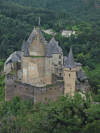


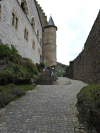





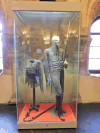
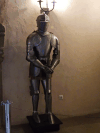
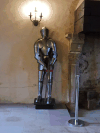
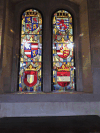
This page contains 22 pictures

Main page for Lëtzebuerg (Luxembourg)
Page last updated on Thu Jul 15 13:41:22 2021 (Mountain Standard Time)
Vianden on guenther-eichhorn.com